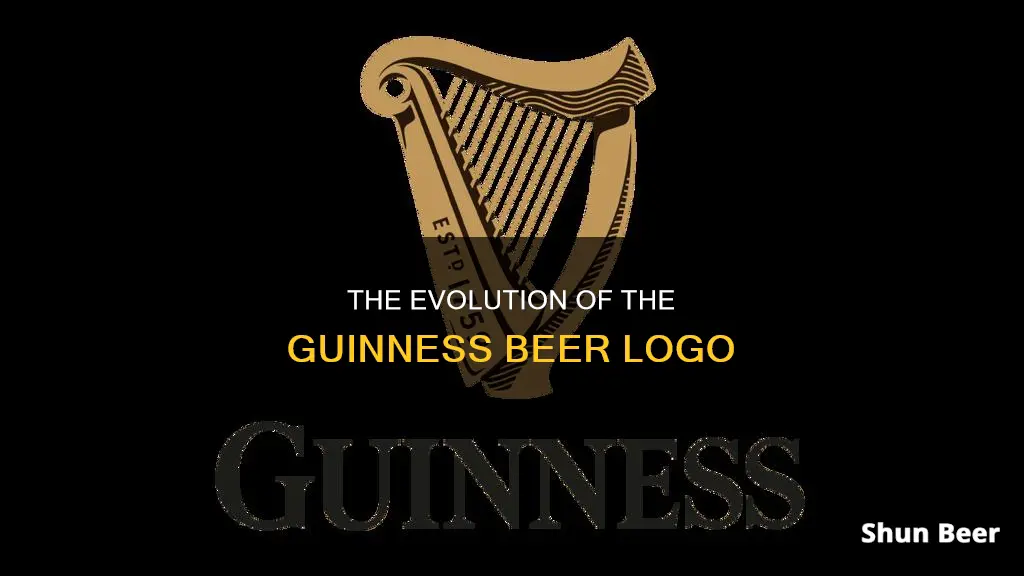
The Guinness logo is a recognisable emblem that has stood the test of time. The harp, a national symbol of Ireland, has been synonymous with the brand since 1862. The harp is based on a 14th-century instrument known as the O'Neill or Brian Boru harp, which is the oldest surviving Gaelic harp. The harp device has been a constant feature of Guinness' visual identity, with the logo undergoing various redesigns since its inception. The current harp was introduced in 2005, with a metallic texture and a simplified design.
| Characteristics | Values |
|---|---|
| First Used | 1862 |
| Registered Trademark | 1876 |
| Colours | Gold, black, white, blue |
| Background Colours | Black, blue, white |
| Harp Type | Brian Boru's Harp, the oldest surviving Gaelic harp |
| Harp Strings | Number of strings has decreased over time to 9 |
| Harp Orientation | Straight edge (soundboard) to the left |
| Wordmark | Yes, custom serif stencil font |
| Wordmark Size | All letters the same size |
| Wordmark Case | All capitals, with the first letter enlarged |
| Date Mark | "Est 1759" in thin white symbols |
| Redesigns | 1955, 1968, 1995, 1997, 2005, 2016 |
What You'll Learn

The harp symbol and its origins
The harp, a Gaelic instrument, has been the logo of Guinness beer since 1862. The harp is a symbol of Ireland and has been used as the country's emblem since the time of King Brian Boru, the first ruler to unify Ireland against the Viking occupation. The harp has been a common emblem in Ireland, featuring on its coat of arms and its coins.
The harp logo was first used by Guinness in 1862, becoming a registered trademark in 1876. The harp used by Guinness is based on a famous 14th-century Irish harp known as the "O'Neill" or "Brian Boru" harp, which is the oldest surviving Gaelic harp. The harp is one of three elements that make up the Guinness livery, the other two being the word "Guinness" and Arthur Guinness's signature.
The harp logo has undergone several redesigns since its inception. In 1955, the logo was simplified to just the harp, drawn in monochrome on a plain white background. In 1968, the harp was given modern contours and a new colour palette, with thick and smooth lines in dark gold placed on a blue background. The number of strings on the harp has also changed over time, with the current version of the harp, introduced in 2005, featuring a simplified design with fewer strings.
The distinguishing feature between the Guinness harp and the Irish government harp is the direction of the straight edge, or soundboard, of the harp. The Guinness harp always appears with the straight edge to the left, while the government harp is shown with the straight edge to the right. This difference was introduced in 1922 when the new Irish government encountered a problem, as Guinness had already been using the harp as a trademark for 50 years. As the harp symbolized unity in Ireland, the government decided to use the symbol but in reverse to the Guinness logo.
Guinness Beer: Carbonation Secrets Revealed
You may want to see also

The evolution of the logo
The Guinness logo is synonymous with the brand and its Irish heritage. The logo has evolved over time, but one symbol has always remained—the harp.
The very first logo for Guinness was created in 1862 and featured a monochrome badge with a double oval outline. The harp was placed in the upper part of the emblem, surrounded by cursive lettering. The harp in the logo is based on a famous 14th-century Irish harp known as the "O'Neill" or "Brian Boru" harp, which is the oldest surviving Gaelic harp. The harp is also the official national emblem of the Republic of Ireland and can be found on its coinage. The harp symbol has been synonymous with Guinness since 1862 and became a registered trademark in 1876.
In 1955, the logo was simplified to just the harp, drawn in monochrome on a plain white background without any lettering or framing. This was a significant change from the detailed and text-heavy original logo.
In 1968, the harp received modern contours and a new color palette. It was now depicted with thick and smooth lines in dark gold and placed on a gradient blue background, evoking a sense of lightness and freedom.
In 1997, the wordmark was added to the logo, with a custom serif stencil font that became synonymous with the brand. The logo featured the word "Guinness" in all capital letters, with the first letter enlarged, adding a sense of timelessness and sophistication. The date mark "est 1759" was also added to the logo, commemorating the year Guinness was founded.
The logo underwent another redesign in 2005, with the golden harp placed on a black background and the inscription in white. The typeface of the inscription was modified to have elongated and sharpened serifs, giving it an elegant and slightly old-style appearance.
The most recent redesign of the Guinness logo took place in 2016, introducing a three-dimensional metallic emblem. The harp was enlarged, and the inscription was updated with a new typeface, retaining the elongated and sharpened serifs.
While the logo has evolved, the harp symbol has remained a constant, enduring feature, reflecting the brand's Irish heritage and its long history.
Guinness Beer: Healthy Choice or Dark Deception?
You may want to see also

The toucan mascot
The Guinness beer logo is synonymous with the harp, an instrument closely associated with Ireland. However, the brand's advertising campaigns have also featured a toucan bird since the 1940s. The toucan was introduced as a symbol of the beer's exotic and adventurous nature, and the tropical bird certainly helped to create a memorable and visually striking image.
The choice of the toucan as a mascot was a strategic one. The toucan, with its bright beak and distinctive appearance, is a far cry from the more traditional harp symbol. The toucan was used to represent the beer's exotic and adventurous nature, a clever marketing tactic to differentiate the brand from its competitors. The use of a tropical bird is also a nod to the beer's international appeal, as it had been exported worldwide by the mid-20th century.
The toucan has become an iconic part of the Guinness brand, even though it is not officially part of the logo. The bird has become intertwined with the brand's identity, a testament to the success of their historical marketing strategy. The toucan adds a touch of whimsy and light-heartedness to the brand, perhaps appealing to a different demographic than the more traditional harp logo.
While the harp logo has remained largely unchanged since its inception in 1862, the toucan mascot has allowed for more creative freedom in advertising. The toucan has been depicted in various poses and settings, always with its colourful beak on display, adding a touch of vibrancy to the brand. The toucan has become an enduring symbol of Guinness, a testament to the brand's longevity and worldwide appeal.
Football Stars in Guinness Beer Ads: Who's Featured?
You may want to see also

The Guinness wordmark
In the 1955 redesign of the logo, the wordmark was removed, leaving only the harp symbol. However, the wordmark was reintroduced in 1997, with all letters the same size, creating a massive and masculine look. This version of the logo also featured the date mark "est 1759" on either side of the emblem.
The 2005 redesign saw another change to the wordmark, with the inscription in white and set in capital letters. The first letter was enlarged compared to the others, adding a sense of timelessness and sophistication.
The latest redesign of the Guinness logo in 2016 kept the wordmark, with the inscription in a new typeface that featured elongated and sharpened serifs, creating an elegant and slightly old-style look.
Throughout the various iterations of the Guinness logo, the wordmark has played a crucial role in balancing the elegant and feminine harp emblem with a strong and masculine element. The custom serif stencil font has become an integral part of the brand's visual identity, instantly recognisable to consumers around the world.
Guinness Beer's Dark Appearance: A Black Mystery Solved
You may want to see also

The logo's colour palette
The Guinness logo has undergone several redesigns since its inception, but its colour palette has always been elegant and impactful. The colour choices have played a significant role in shaping the brand's image and presence over the years.
The very first logo for Guinness, created in 1862, featured a monochrome badge with a double oval outline and an ornate wordmark in two different styles. The harp, which has become synonymous with the brand, was placed in the upper part of the emblem, surrounded by cursive lettering. This logo, with its detailed design and monochrome hues, established a strong and professional image for the brand.
In 1955, the logo underwent a significant change. It was simplified to feature only the harp, drawn with intricate details in monochrome, against a plain white background. This marked a shift towards a more minimalist approach, allowing the iconic harp symbol to take centre stage.
A decade later, in 1968, the logo evolved again. The harp was given modern contours and a renewed colour palette. Thick and smooth lines, executed in dark shades, were set against a gradient blue background. This colour scheme evoked a sense of lightness and freedom, adding a contemporary twist to the traditional harp symbol.
The year 1997 saw the reintroduction of the wordmark, with a custom serif stencil font that became an integral part of the brand's identity. The colour palette was further refined in 2005, with the golden harp placed on a black background and complemented by a white inscription. This combination of gold, black, and white created a timeless and sophisticated aesthetic.
The most recent redesign in 2016 introduced a three-dimensional metallic emblem, enhancing the visual impact of the logo. The harp was enlarged, and the white inscription was updated with a new typeface, resulting in an elegant and slightly old-style look.
Throughout its history, the Guinness logo has utilised a carefully curated colour palette to convey a sense of elegance, strength, and sophistication. The combination of monochrome hues, golden accents, and strategic use of colour backgrounds has contributed to the brand's enduring visual appeal.
Guinness Nitro Beer: What Are Those IBUs?
You may want to see also
Frequently asked questions
The symbol on the Guinness logo is a harp.
The harp is a Gaelic instrument and a common emblem of Ireland. The harp on the Guinness logo is based on a famous 14th-century Irish harp known as the "O'Neill" or "Brian Boru" harp.
The harp was first used on the Guinness logo in 1862. It became a registered trademark in 1876.
In addition to the harp, the Guinness logo features the word "Guinness" and Arthur Guinness's signature.
Yes, the Guinness logo has undergone several redesigns since its inception. The logo has been simplified over the years, with details removed or reduced from the harp design. The font and colour palette have also been updated.







